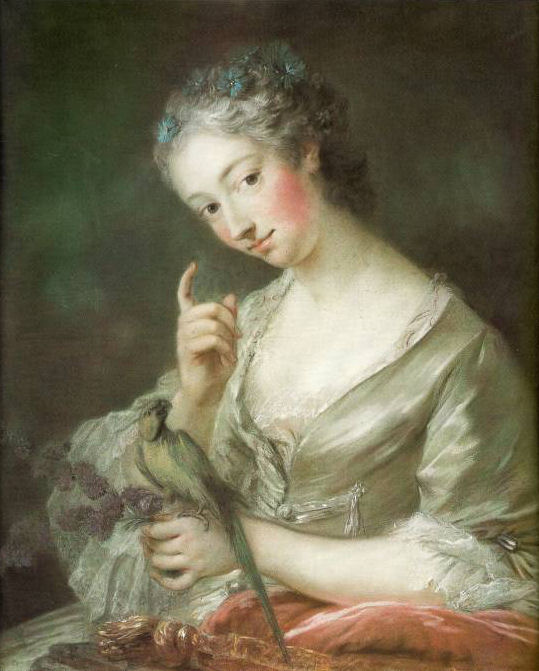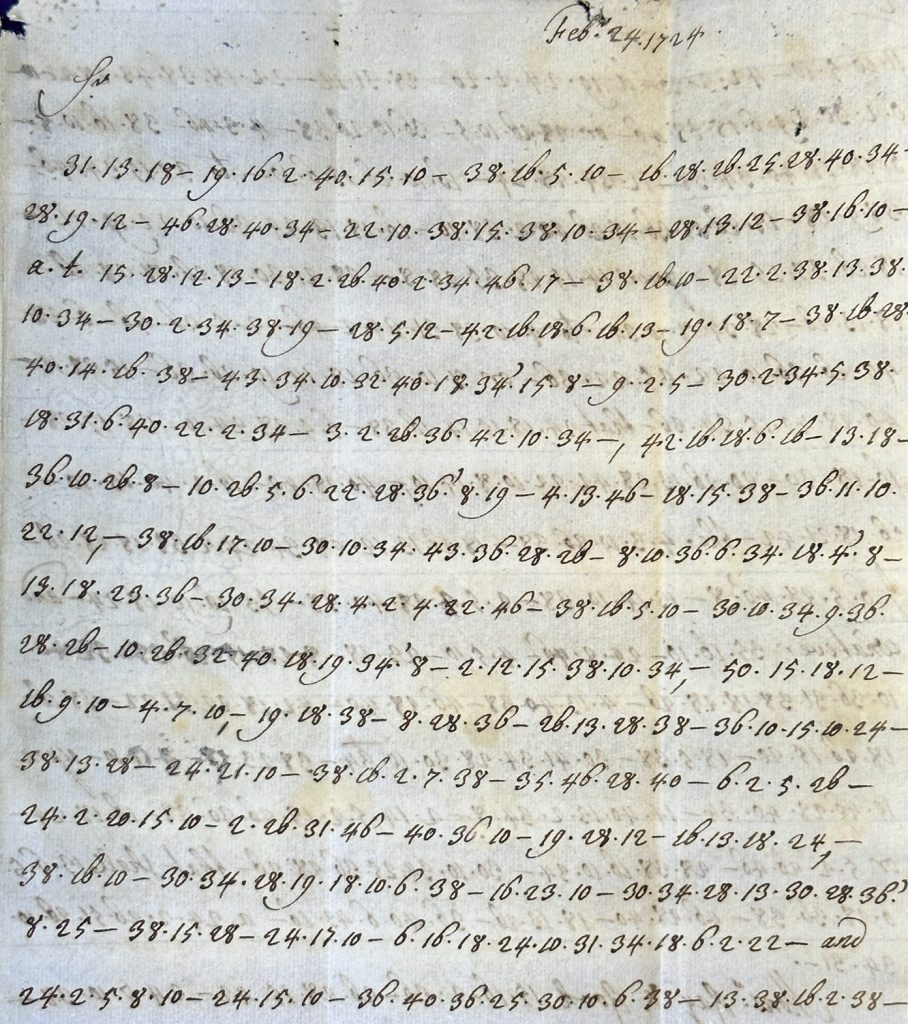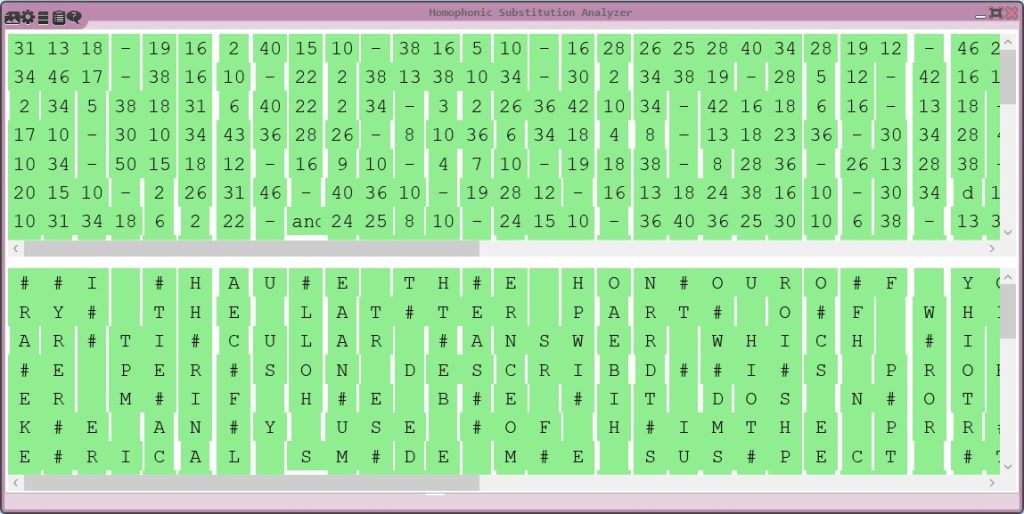In a routine cataloging task at the University College London (UCL) Special Collections, an interesting and mystical 1724 encrypted letter came to light, which captured my attention. As someone deeply involved in the field of historical cryptography, I was drawn into the process of decrypting this document. This blog article details my journey in decrypting the letter, the methods I employed, the historical context, and the insights we gained.

Discovery of the Letter and Contact to the Archive
Katy Makin, an archivist at UCL, discovered the encrypted letter while cataloging the Brougham Archives. These archives are primarily associated with Henry Brougham, 1st Baron Brougham and Vaux, a notable British statesman of the 19th century. However, the letter predates Brougham’s birth by over 50 years, indicating it might be linked to one of his ancestors involved in the political affairs of the early 18th century.
Katy decided to share images of the letter on social media, specifically on X (formerly known as Twitter), in hopes of finding someone able to decipher it. I came across these images on X, and given my background in decrypting historical documents, I was immediately captivated by the challenge.
After I was able to decipher the first pages shown on X, I immediateley realized that there have to be more. I contacted Katy, showed her my decryption and also asked for more pages. She sent all pages to me which I also was able to decipher. Unfortunately, it also turned out that some pages are missing since the letter has no proper ending and indicates that. Ultimatively, Katy and I wrote a research article about the letter and published it on the HistoCrypt 2024 in Oxford. I also presented the letter in the poster session on the HistoCrypt which I really enjoyed.

Initial Analysis and Hypotheses
When I first examined the letter, it appeared to be encrypted using a homophonic substitution cipher—a method designed to obscure letter frequencies by using multiple symbols for individual letters. The letter consisted of 16 pages filled with numbers, dots, and dashes, with a few plaintext words like “and” and “the” and names such as “Mons Garnet and Gee” standing out. This mixture of encryption and plaintext hinted at a complex approach that piqued my curiosity.
Given the structure and content, I initially hypothesized that the letter might use a homophonic substitution cipher, where different numbers or symbols corresponded to letters or groups of letters. This assumption seemed plausible, especially with 52 different numbers appearing throughout the text, which might represent the plaintext alphabet and additional syllables or words.
The Decryption Process
To begin the decryption, I first transcribed the entire text into a digital format, recording every number, dot, and dash to ensure I had an accurate replica of the original document. This transcription allowed for a detailed analysis using CrypTool 2, our open-source software that I frequently use for analyzing and breaking classical ciphers, e.g. in videos on my YouTube channel.
My initial attempts at automated decryption using the Homophonic Substitution Analyzer provided some partial results, but there were still many nonsensical sequences, which led me to suspect the presence of nulls. These symbols are often used to mislead those attempting to decrypt the text, adding an extra layer of difficulty.
Through further cryptanalysis, I discovered that the encryption was simpler than I had initially thought. After identifying and removing the nulls, I realized that the letter used a basic monoalphabetic substitution cipher, where even numbers corresponded to letters in a straightforward ascending order (e.g., A = 2, B = 4, C = 6, etc.). With this finding, I was able to successfully decrypt the main content of the letter.

Unresolved Elements and Historical Context
Despite the successful decryption of most of the text, certain elements remained unresolved. The letter contained “nomenclature elements”— special codewords likely used to hide e.g. the identities of people and places. These codewords, such as “Mons Garnet and Gee” or “Mons Grandy and Gay,” appeared in pairs and often featured alliteration. Their exact meaning remains unclear, suggesting these elements were intended to provide additional security, perhaps related to sensitive political or military issues.
The letter was written during a time of significant political tension in Britain, particularly concerning the Jacobite efforts to restore the Stuart dynasty to the throne. The use of encryption shows the sensitive nature of the topics discussed, reflecting the secretive communications common during this turbulent period.
Content of the letter
Here is the decryption of the first two pages of the letter:
Page 1: Feb 24 1724I HAUE THE HONOUR OF YOUR LETTER OF THE ?? OF IANUARY THE LATTER PART OF WHICH I THOUGHTREQUIRED A PARTICULAR ANSWER WHICH I SENDENCLOS BY ITSELF. THE PERSON DESCRIBD ISPROBABLY THE PERSON ENQUIRD AFTER AND IF HEBE IT DOS NOT SEEM TO ME THAT YOU CAN MAKEANY USE OF HIM. THE PROIECT HE PROPOSD TO MECHIMERICAL and MADE ME SUSPECT THAT
Page 2: HE WAS a MAN OF LITTLE CAPACITY OR ONE SENTBY THE COURT FROM HENCE TO TRY TO INSINUATEHIMSELF INTO YOUR GOOD OPINION IN ORDER TOBETRAY ANY CIUNSELLS OR DESIGNS OF YOURS THATMIGHT COME TO HIS KNOWLEDGE YOU HAUE. NOBATHE BEST INFORMATION JCOUD GET ABOUT HIM and whatever HE MAY BE I DONT QUESTION BUT YOUWILL THINK IT PROPER TO BE upon YOUR GUARDAGAINST HIA OR ANY OTHER PERSON THAT SHALLCOST YOU IN SUCH A MANNER. Mons Ray & Rook HAS NOW MET …
The complete decryption can be found in the DECODE database: https://de-crypt.org/decrypt-web/RecordsView/6317
The Role of Madame de Prie in the 1724 Encrypted Letter
One of the most interesting parts of the decrypted 1724 letter is the mention of Madame de Prie, a prominent figure in French political circles during the early 18th century. Madame de Prie, the mistress of the Duke of Bourbon (“Monsieur Le Duc”), wielded significant influence at the French court, since she was basically in full control of the duke. The letter hints at her potential involvement in a secretive political scheme, suggesting that her support should be secured — through financial incentives. Interestingly, she was the only person not mentioned using a code name, which we identified so far.
Conclusion
Deciphering this 1724 letter was a really fascinating project, giving me insights into the methods of communication and encryption used in the early 18th century in England. But also, it kept me wondering why such important political communication was not secured with a more secure cipher than just a simple monoalphabetic substitution. Finally, the unresolved nomenclature elements left open the possibility of further research to identify the mentioned persons and places. This is now up to the historians :-).
References
Kopal, Nils und Makin, Katy. „Decipherment of an Encrypted Letter from 1724 Found in UCL Special Collections’ Brougham Archive”. In Proceedings of the 7th International Conference on Historical Cryptology (HistoCrypt 2024), Oxford/Bletchley Park, UK, 2024: URL: https://doi.org/10.58009/aere-perennius0104
